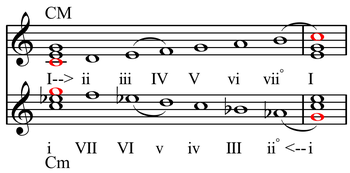
Riemannian theory, in general, refers to the musical theories of German theorist Hugo Riemann (1849–1919). His theoretical writings cover many topics, including musical logic,[1] notation,[2] harmony,[3] melody,[4] phraseology,[5] the history of music theory,[6] etc. More particularly, the term Riemannian theory often refers to his theory of harmony, characterized mainly by its dualism and by a concept of harmonic functions.
YouTube Encyclopedic
-
1/3Views:30 264758189 633
-
Introduction to Neo-Riemannian Theory
-
Triadic Transformation Theory (Neo-Reimannian Theory) An Introduction
-
Practical Usage of Advanced Musical Theory
Transcription
Dualism
Riemann's "dualist" system for relating triads was adapted from earlier 19th-century harmonic theorists. The term "dualism" refers to the emphasis on the inversional relationship between major and minor, with minor triads being considered "upside down" versions of major triads; this "harmonic dualism" (harmonic polarity) is what produces the change-in-direction described above. See also the related term utonality.[7]
Transformations
In the 1880s, Riemann proposed a system of transformations that related triads directly to each other. Riemann's system had two classes of transformations: "Schritt" and "Wechsel".[7] A Schritt transposed one triad into another, moving it a certain number of scale steps. For example, the "Quintschritt" (literally "five-step" in a mixture of Latin and German) transposed a triad by a perfect fifth, transforming C major into G major (up) or F major (down). A Wechsel inverted a triad according to the Riemann's theory of dualism, mapping a major triad to a minor triad. For example, Seitenwechsel ("die Seiten wechseln" translates as "to exchange sides") mapped a triad on to its parallel minor or major, transforming C major to C minor and conversely.[7] Riemann's theory of transformations formed the basis for Neo-Riemannian theory, which expanded the idea of transformations beyond the basic tonal triads that Riemann was mostly concerned with.
See also
Sources
- ^ Musikalische Logik. Hauptzüge der physiologischen und psychologischen Begründung unseres Musik-systems, Leipzig, 1873.
- ^ Studien zur Geschichte der Notenschrift, Leipzig, 1878; Die Entwickelung unserer Notenschrift, Leipzig, 1881; Notenschrift und Notendruck, Leipzig, 1896.
- ^ Skizze einer neuen Methode der Harmonielehre, Leipzig, 1880; Handbuch der Harmonielehre, Leipzig, 1887; Vereinfachte Harmonielehre, London/New York, 1893.
- ^ Neue Schule der Melodik, Hamburg, 1883.
- ^ Katechismus der Phrasierung, Leipzig, 1890, 2d edition Vademecum der Phrasierung, 1900, 8th edition as Handbuch der Phrasierung.
- ^ Geschichte der Musiktheorie im IX.–XIX. Jahrhundert, Berlin, 1898.
- ^ a b c Klumpenhouwer, Henry, Some Remarks on the Use of Riemann Transformations, Music Theory Online 0.9 (1994).

